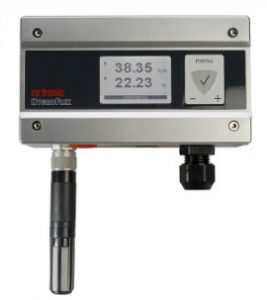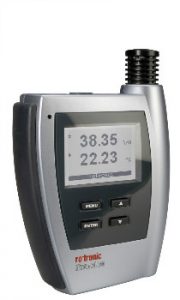Freeze Drying and the Need to Measure Humidity
Freeze Drying in General
The freeze drying method can be traced back to prehistoric times and was used by the Incas who stored their crops on the mountain heights above Machu Picchu: the cold mountain temperatures froze the food and the water inside slowly vaporized under the low air pressure of the high altitudes.
How freeze drying works.
Freeze drying involves the removal of water or other solvent from a frozen product by a process called sublimation. Sublimation occurs when a frozen liquid goes directly to the gaseous state without passing through the liquid phase.
The freeze drying process consists of three stages: prefreezing, primary drying and secondary drying.
Prefreezing:
Material intended to be freeze dried must first be prefrozen below its eutectic temperature.
Primary drying:
 After prefreezing the product, conditions must be established in which ice can be removed from the product via sublimation. This requires very careful control of two parameters: temperature and pressure (the pressure is controlled with a vacuum pump). The rate of sublimation of ice from a frozen product depends upon the difference in vapour pressure of the product compared to the vapour pressure of the ice collector. Molecules migrate from the higher pressure sample to the lower pressure sample. Since vapour pressure is related to temperature, it is also necessary that the product temperature is warmer than the ice trap temperature.
After prefreezing the product, conditions must be established in which ice can be removed from the product via sublimation. This requires very careful control of two parameters: temperature and pressure (the pressure is controlled with a vacuum pump). The rate of sublimation of ice from a frozen product depends upon the difference in vapour pressure of the product compared to the vapour pressure of the ice collector. Molecules migrate from the higher pressure sample to the lower pressure sample. Since vapour pressure is related to temperature, it is also necessary that the product temperature is warmer than the ice trap temperature.
Secondary drying:
After primary freeze drying is complete and all ice has sublimed but bound water is still present in the product. Continued drying is necessary at warmer temperatures to remove the residual water. This process is called isothermal desorption as the bound water is desorbed from the sample. During secondary drying, the product temperature is higher than ambient. All of the other conditions, such as pressure and ice trap temperature remain the same.
Why the Need to Measure the Relative Humidity?
Advantages and Inconvenience
People use freeze drying to preserve material, such as pharmaceuticals. Many pharmaceuticals will degrade pretty quickly when exposed to water and air, for the same basic reason that food degrades. Chemists can greatly extend pharmaceutical shelf life by freeze drying the material and storing it in a container free of oxygen and water. Similarly, research scientists may use freeze drying to preserve biological samples for long periods of time. Freeze dried biological samples are also big in the florist world. The freeze drying process has also been used to restore water damaged materials, such as rare and valuable manuscripts.
Freeze dried material can be stored at warmer temperatures without suffering degradation.
Freeze dried products can be stored without cryogenic or freezing facilities, the energy cost and the risk of product loss from power failure is greatly reduced.
As the product is dried out without excessive heating, proteins and other products that would be thermally denatured can be successfully preserved without loss of activity.
As products are much lighter when they are dry, freeze drying offers the benefit of reducing transport costs.
Compared to advantages, the only disadvantage is that freeze drying is a very expensive process in terms of high investment and maintenance costs and the production capacity is limited due to the long process time.
As freeze drying is an expensive process, once the product is freeze dried, it is important that it is monitored during the rest of the life span of the product.
Optimizing the Process
 Air Inlets: During the freeze drying process the air inlets must be monitored. The dryer the air entering the room, the better.
Air Inlets: During the freeze drying process the air inlets must be monitored. The dryer the air entering the room, the better.
By their nature, freeze dried products are hygroscopic and exposed to water during storage can destabilize the product. This means that the freeze dried products can “never” leave a controlled zone.
The control of the storage area where freeze dried products are placed is compulsory.
The freeze drying process never comes alone, once the product is dry, there is a need to pack the product: there are always filling machines that are placed in a sterile areas or isolators where humidity must be con-trolled and can be sterilized with hydrogen peroxide.
Residual humidity in elastomeric stoppers can cause degradation of freeze dried products. Prior to packaging the product, stoppers are typically washed, steam sterilized and dried. The steam sterilization process drives humidity into the stopper. If the drying conditions for the stopper are not optimized, residual humidity can transfer into the freeze dried product over time.
Packaging used for freeze dried materials must be impermeable to relative humidity.
What solutions can Rotronic offer?
Rotronic attests that the validated version of the Rotronic HW4 software and the associated devices fulfill the requirements defined in the Rotronic ERES white paper based on the following paragraphs:
- 21 CFR Part 11,
- 21 CFR 110,
- 21 CFR 210,
- 21 CFR 211,
- EU Annex 11 to the EU guidelines of good manufacturing prac-tice for medicinal products.
Rotronic Products:
Humidity and temperature probes:
- HC2-S Standard humidity sensor, -50…100°C, 0…100%rh, ±0.8%rh and ±0.1K…
- HC2-IM Chrome nickel steel Industrial probe, -100…200°C, 0…100%rh, ±0.8%rh and ±0.1K…
- HC2-P05 Insertion probe, -40…85°C, 0…100%rh, ±1.5%rh and ±0.3K…
Transmitters:
- HF5 series For interchangeable probes, 2 or 3/4 wire configuration, Various analog and digital outputs, Display, All psychrometric calculations available…
- HF7 series Stainless steel probe, -100…200°C, 3/4 wire configuration, Various analog outputs, Display…
- HL-NT For interchangeable probes (up to 7 probes with docking station) 32MB flash card, Display, Conform to FDA21 CFR Part 11 and GAMP4…
- HL-20 20’000 measurement pairs, Display, ±0.8%rh and ±0.2K, Conform to FDA21 CFR Part 11 and GAMP4…
Customer Benefits:
Interchangeability:
The Rotronic product range is setup around the interchangeability feature of the HC2 probes. Be it with loggers or transmitters, there is always the possibility of interchangeable probes.
When calibration is required, it is easy to remove a probe from a transmitter rather than removing the entire transmitter from the wall.
On the same level, it is possible to test a system loop with using a Rotronic simulator probe that gives fixed outputs. Plug this into the transmitter and see if the loop works correctly!
Calibration and Adjustment:
Calibration and adjustment is very easy with the Rotronic product range. As all of the communication is digital, the whole calibration procedure can be done via a PC, or directly from the device with the help of the Rotronic humidity standards. Rotronic can also offer a factory calibration (certified or not).
Communication:
With all of the different communication methods, from RS-485, Wireless to Ethernet RJ45, Rotronic can provide the solution for each installation.
Long Term Stability:
A long term stability with a drift under 1%rh per year (depending on the environment).
Source: Rotronic

